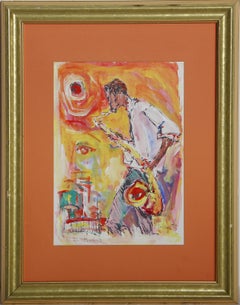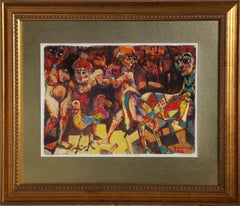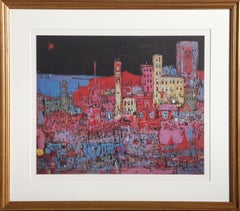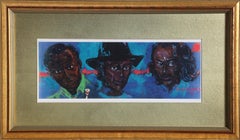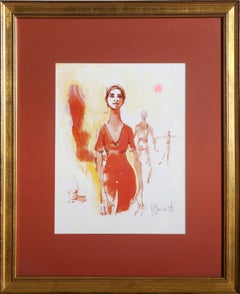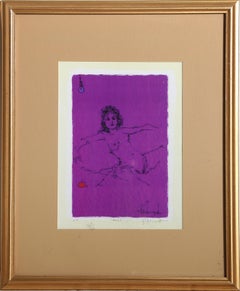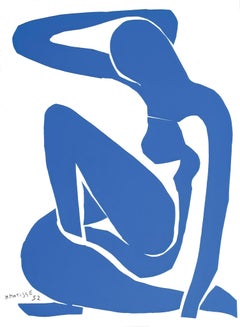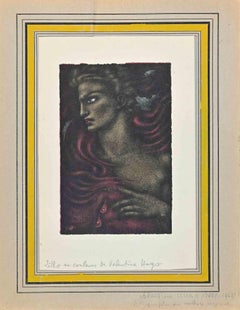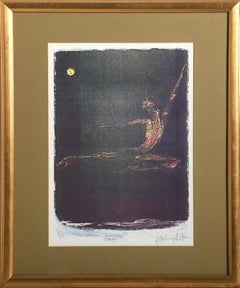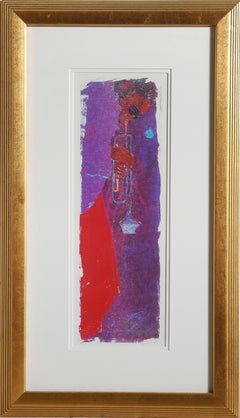Alvin C. Hollingsworth Prints and Multiples
to
1
9
3
1
Overall Width
to
Overall Height
to
9
3
1
15
1,204
948
934
834
14
1
1
10
2
10
4
8
6
5
4
3
2
2
1
1
1
1
11
3
14
14
Artist: Alvin C. Hollingsworth
Le Jazz Hot, Modern Hand-Colored Lithograph by Alvin Carl Hollingsworth
By Alvin C. Hollingsworth
Located in Long Island City, NY
Alvin Carl Hollingsworth, American (1928 - 2000) - Le Jazz Hot, Year: circa 1990, Medium: Hand painted Lithograph on paper, signed lower left in pencil, Size: 14 x 9.75 in. (35.56...
Category
1990s Modern Alvin C. Hollingsworth Prints and Multiples
Materials
Lithograph
Equis Allegory, Surrealist Hand-Colored Lithograph by Alvin Carl Hollingsworth
By Alvin C. Hollingsworth
Located in Long Island City, NY
Alvin Carl Hollingsworth, American (1928 - 2000) - Equis Allegory, Year: circa 1960, Medium: Hand painted Lithograph on paper, signed in the plate lower right, Size: 11 x 15.5 in....
Category
1960s Surrealist Alvin C. Hollingsworth Prints and Multiples
Materials
Lithograph
Cityscape, Modern Lithograph by Alvin Carl Hollingsworth
By Alvin C. Hollingsworth
Located in Long Island City, NY
Alvin Carl Hollingsworth, American (1928 - 2000) - Cityscape, Medium: Lithograph, signed in the plate lower right, Image Size: 13 x 15.75 inches, Frame Size: 19.5 x 22.25 inches, ...
Category
1980s Modern Alvin C. Hollingsworth Prints and Multiples
Materials
Lithograph
3 Miles, Modern Lithograph by Alvin Carl Hollingsworth
By Alvin C. Hollingsworth
Located in Long Island City, NY
Alvin Carl Hollingsworth, American (1928 - 2000) - 3 Miles, Medium: Lithograph, Image Size: 5.75 x 16.5 inches, Frame Size: 14.25 x 24.25 inches, Description: This lithograph by ...
Category
1980s Modern Alvin C. Hollingsworth Prints and Multiples
Materials
Lithograph
Rehearsal, Modern Hand-Colored Lithograph by Alvin Carl Hollingsworth
By Alvin C. Hollingsworth
Located in Long Island City, NY
Alvin Carl Hollingsworth, American (1928 - 2000) - Rehearsal, Year: circa 1970, Medium: Hand colored lithograph, signed lower right, Size: 13 x 10 in. (33.02 x 25.4 cm), Frame Siz...
Category
1970s Modern Alvin C. Hollingsworth Prints and Multiples
Materials
Lithograph
Apple, Modern Hand-Colored Lithograph by Alvin Carl Hollingsworth
By Alvin C. Hollingsworth
Located in Long Island City, NY
Alvin Carl Hollingsworth, American (1928 - 2000) - Apple, Year: circa 1990, Medium: Hand colored Lithograph, signed, titled and numbered in pencil, Edition: AP, Image Size: 10.75...
Category
1990s Modern Alvin C. Hollingsworth Prints and Multiples
Materials
Lithograph
Equis Equitude, Cubist Lithograph by Alvin Carl Hollingsworth
By Alvin C. Hollingsworth
Located in Long Island City, NY
Alvin Carl Hollingsworth, American (1928 - 2000) - Equis Equitude, Medium: Lithograph, signed and numbered in pencil, Edition: PP, Image Size: 9 x 4.5 inches, Frame Size: 18.5 x ...
Category
1980s Cubist Alvin C. Hollingsworth Prints and Multiples
Materials
Lithograph
Art isnt Easy, Surrealist Hand-Colored Lithograph by Alvin Carl Hollingsworth
By Alvin C. Hollingsworth
Located in Long Island City, NY
Alvin Carl Hollingsworth, American (1928 - 2000) - Art isnt Easy, Year: circa 1980, Medium: Hand colored Lithograph, signed in the plate, Size: 10.25 x 8 in. (26.04 x 20.32 cm), F...
Category
1980s Surrealist Alvin C. Hollingsworth Prints and Multiples
Materials
Lithograph
Ecstasy, Modern Monoprint by Alvin Carl Hollingsworth
By Alvin C. Hollingsworth
Located in Long Island City, NY
Alvin Carl Hollingsworth, American (1928 - 2000) - Ecstasy, Medium: Monoprint, signed and titled in pencil, Image Size: 10 x 7.75 inches, Frame Size: 16 x 13.5 inches, Description...
Category
1980s Modern Alvin C. Hollingsworth Prints and Multiples
Materials
Monoprint
Torso, Modern Lithograph by Alvin Carl Hollingsworth
By Alvin C. Hollingsworth
Located in Long Island City, NY
Alvin Carl Hollingsworth, American (1928 - 2000) - Torso, Medium: Lithograph, signed, titled and numbered in pencil, Edition: AP, Image Size: 22.25 x 17.5 inches, Frame Size: 37....
Category
1980s Modern Alvin C. Hollingsworth Prints and Multiples
Materials
Lithograph
Jet Stream Nude, Abstract Monoprint by Alvin Carl Hollingsworth
By Alvin C. Hollingsworth
Located in Long Island City, NY
Alvin Carl Hollingsworth, American (1928 - 2000) - Jet Stream Nude, Medium: Monoprint, signed lower left, Size: 10.5 x 16.5 in. (26.67 x 41.91 cm), Frame Size: 20 x 26 inches, Des...
Category
1980s Abstract Alvin C. Hollingsworth Prints and Multiples
Materials
Monoprint
Nude, Modern Hand-Colored Lithograph by Alvin Carl Hollingsworth
By Alvin C. Hollingsworth
Located in Long Island City, NY
Alvin Carl Hollingsworth, American (1928 - 2000) - Nude, Medium: Hand colored Lithograph, signed, titled and numbered in pencil, Edition: AP, Image Size: 18 x 9.25 inches, Frame S...
Category
1980s Modern Alvin C. Hollingsworth Prints and Multiples
Materials
Lithograph
Nude #3, Modern Lithograph by Alvin Carl Hollingsworth
By Alvin C. Hollingsworth
Located in Long Island City, NY
Alvin Carl Hollingsworth, American (1928 - 2000) - Nude #3, Medium: Lithograph, signed in the plate lower right, Size: 13.25 x 9.75 in. (33.66 x 24.77 cm), Frame Size: 21 x 17 inc...
Category
1980s Modern Alvin C. Hollingsworth Prints and Multiples
Materials
Lithograph
Golden Dreamscape, Surrealist Monoprint by Alvin Carl Hollingsworth
By Alvin C. Hollingsworth
Located in Long Island City, NY
Alvin Carl Hollingsworth, American (1928 - 2000) - Golden Dreamscape, Year: circa 1980, Medium: Monoprint, signed in the plate, Size: 13 x 10.5 in. (33.02 x 26.67 cm), Frame Size:...
Category
1980s Surrealist Alvin C. Hollingsworth Prints and Multiples
Materials
Monoprint
Related Items
Henri Matisse, Blue Nude VI, from Verve, Revue Artistique, 1958 (after)
By Henri Matisse
Located in Southampton, NY
This exquisite lithograph after Henri Matisse (1869–1954), titled Nu Bleu VI (Blue Nude VI), from Verve, Revue Artistique et Litteraire, Vol. IX, No. 35–36, originates from the 1958 ...
Category
1950s Modern Alvin C. Hollingsworth Prints and Multiples
Materials
Lithograph
$1,436 Sale Price
20% Off
H 13.25 in W 10.25 in
Revenge - Original Lithograph by Valentine Hugo - Mid 20th century
By Valentine Hugo
Located in Roma, IT
Revenge is an original Lithograph realized in mid-20th Century by Valentine Hugo (1887-1968).
In good condition.
The artwork is depicted skillfully t...
Category
Mid-20th Century Modern Alvin C. Hollingsworth Prints and Multiples
Materials
Lithograph
$358
H 6.89 in W 4.53 in D 0.04 in
Marc Chagall - Double Portrait - Original Lithograph
By Marc Chagall
Located in Collonge Bellerive, Geneve, CH
Marc Chagall, Original Lithograph depicting an instant of the Bible.
Technique: Original lithograph in colours
Year: 1956
Sizes: 35,5 x 26 cm / 14" x 10.2" (sheet)
Published by: Édit...
Category
1950s Modern Alvin C. Hollingsworth Prints and Multiples
Materials
Lithograph
$1,550
H 13.98 in W 10.24 in D 0.04 in
Max Ernst, Portrait of an Insect, from Cahiers d'Art, 1949 (after)
By Max Ernst
Located in Southampton, NY
This exquisite lithograph and pochoir after Max Ernst (1891–1976), titled Portrait dinsecte (Portrait of an Insect), from the album Cahiers dArt No. 24, 1949, originates from the 194...
Category
1940s Surrealist Alvin C. Hollingsworth Prints and Multiples
Materials
Lithograph
$716 Sale Price
34% Off
H 13.375 in W 9.5 in
Nude Woman with Tree - Original Lithograph by Jacques Busse - Mid 20th Century
By Jacques Busse
Located in Roma, IT
Nude woman with tree is an original artwork realized by French artist Jacques Busse (1922-2004)
Lithograph print.
Hand-signed on the lower right in pe...
Category
Mid-20th Century Modern Alvin C. Hollingsworth Prints and Multiples
Materials
Lithograph
$299
H 11.03 in W 14.97 in D 0.08 in
Female Nude - Lithograph by Nicolas Gloutchenko - 1928
By Nicolas Gloutchenko
Located in Roma, IT
Female nude is an original artwork realized by Nicolas Gloutchenko in 1928.
Lithograph on paper.
Hand-signed in pencil by the artist on the lower and numbered, edition of 8/12 prin...
Category
1920s Modern Alvin C. Hollingsworth Prints and Multiples
Materials
Lithograph
$333
H 14.97 in W 11.03 in D 0.04 in
after Henri Matisse - Acrobat
By Henri Matisse
Located in Collonge Bellerive, Geneve, CH
after Henri Matisse - Acrobat
Edition of 200
with the printed signature, as issued
76 x 56
With stamp of the Succession Matisse
References : Artvalue - Succession Matisse
Category
1950s Modern Alvin C. Hollingsworth Prints and Multiples
Materials
Lithograph
Grand Maternity - Handsigned - (after) Pablo Picasso
By Pablo Picasso
Located in Collonge Bellerive, Geneve, CH
After PABLO PICASSO (1881-1973)
Maternity (Grande Maternité)
1963
Offset Lithograph on Paper
Signed and Dated
Handsigned in Pencil
Numbered: 73/200
9...
Category
1960s Modern Alvin C. Hollingsworth Prints and Multiples
Materials
Lithograph
The Judgment of Paris
By Salvador Dalí
Located in Hollywood, FL
ARTIST: Salvador Dali
TITLE: The Judgment of Paris
MEDIUM: Lithograph
SIGNED: Hand Signed by Salvador Dali
EDITION NUMBER: 226/250
MEASUREMENTS: 21.5" x 29.5"
YEAR: 1979
FRAM...
Category
1970s Surrealist Alvin C. Hollingsworth Prints and Multiples
Materials
Lithograph
Henri Matisse, Blue Nude XII, from Verve, Revue Artistique, 1958 (after)
By Henri Matisse
Located in Southampton, NY
This exquisite lithograph after Henri Matisse (1869–1954), titled Nu Bleu XII (Blue Nude XII), from Verve, Revue Artistique et Litteraire, Vol. IX, No. 35–36, originates from the 195...
Category
1950s Modern Alvin C. Hollingsworth Prints and Multiples
Materials
Lithograph
$1,436 Sale Price
20% Off
H 13.25 in W 10.25 in
Rene Magritte, Untitled, from Poems 1923-1958, 1959 (after)
By René Magritte
Located in Southampton, NY
This exquisite lithograph after Rene Magritte (1898–1967), titled Sans titre (Untitled), from the album Poems 1923-1958, Dix dessins de Rene Magritte (Ten Drawings by Rene Magritte),...
Category
1950s Surrealist Alvin C. Hollingsworth Prints and Multiples
Materials
Lithograph
$716 Sale Price
20% Off
H 11 in W 8.25 in
Alexander Calder, Card Players III, from Derriere le Miroir, 1975
By Alexander Calder
Located in Southampton, NY
This exquisite lithograph by Alexander Calder (1898–1976), titled Joueurs de cartes III (Card Players III), originates from the historic 1975 folio Derriere le Miroir, No. 212. Publi...
Category
1970s Surrealist Alvin C. Hollingsworth Prints and Multiples
Materials
Lithograph
$716 Sale Price
20% Off
H 15 in W 22 in
Previously Available Items
Leap, Modern Lithograph by Alvin Carl Hollingsworth
By Alvin C. Hollingsworth
Located in Long Island City, NY
Alvin Carl Hollingsworth, American (1928 - 2000) - Leap, Medium: Lithograph, signed, titled and numbered in pencil, Edition: AP, Image Size: 12 x 8.5 inches, Frame Size: 18 x 15 ...
Category
1980s Modern Alvin C. Hollingsworth Prints and Multiples
Materials
Lithograph
Magnificent Miles, Modern Lithograph by Alvin Carl Hollingsworth
By Alvin C. Hollingsworth
Located in Long Island City, NY
Alvin Carl Hollingsworth, American (1928 - 2000) - Magnificent Miles, Medium: Lithograph, signed titled and numbered in pencil, Edition: 2/5, Image Size: 16.5 x 5 inches, Frame Si...
Category
1980s Modern Alvin C. Hollingsworth Prints and Multiples
Materials
Lithograph
Guggenheim in Yellow, Modern Lithograph by Alvin Carl Hollingsworth
By Alvin C. Hollingsworth
Located in Long Island City, NY
Alvin Carl Hollingsworth, American (1928 - 2000) - Guggenheim in Yellow, Medium: Lithograph, signed, titled and numbered in pencil, Edition: 122/125, Image Size: 16 x 20 inches, F...
Category
1980s Modern Alvin C. Hollingsworth Prints and Multiples
Materials
Lithograph
Last Supper Revisited, Modern Lithograph by Alvin Carl Hollingsworth
By Alvin C. Hollingsworth
Located in Long Island City, NY
Alvin Carl Hollingsworth, American (1928 - 2000) - Last Supper Revisited, Year: 1993, Medium: Lithograph, signed, titled, numbered and dated in pencil, Edition: PP, Image Size: 7...
Category
1990s Modern Alvin C. Hollingsworth Prints and Multiples
Materials
Lithograph
Alvin C. Hollingsworth prints and multiples for sale on 1stDibs.
Find a wide variety of authentic Alvin C. Hollingsworth prints and multiples available for sale on 1stDibs.
